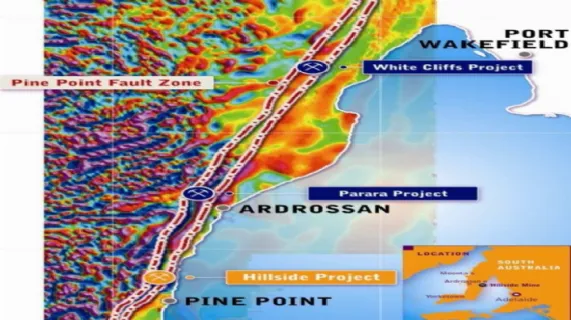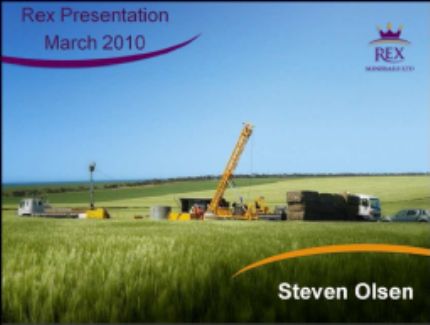
Rex Minerals Limited (ASX:RXM)
Melbourne, June 22, 2009 AEST (ABN Newswire) - Rex Minerals Limited (ASX:RXM) will accelerate its exploration efforts in South Australia's Pine Point Copper Belt after the successful capital raising managed by EL&C Baillieu Stockbroking Ltd in May, 2009.
Over the last twelve months Rex has made significant large scale copper discoveries at its Hillside Project in the Pine Point Copper Belt.
The outstanding drilling results at Hillside so far include:
259m @ 1.7% copper and 0.4g/t gold57m @ 1.5% copper and 0.4g/t gold51m @ 1.5% copper and 0.1g/t gold12m @ 2.0% copper and 0.4g/t gold
Rex has 100% ownership of a 60km long section of the Pine Point Copper Belt (defined by the Pine Point Fault), which extends along the east coast of the Yorke Peninsula in South Australia. Rex believes that most of the copper in the region was hidden from earlier explorers by 10 to 50 metres of sediments and that modern exploration tools have begun to reveal an entirely new frontier of exploration in the region.
Rex has shown that large scale mineralisation exists underneath the shallow sediments at Hillside and that further copper discoveries, combined with a strategically favourable location, could deliver a large-scale, low cost and long-life mining operation on the Yorke Peninsula.
Rex has recently completed a comprehensive technical review of the mineralisation discovered to date at Hillside which concluded that local and regional geophysical programs could help to discover extensions to the known copper mineralisation and determine the location of additional high grade copper.
Rex's Managing Director Mr Steve Olsen said "the effective use of geophysical tools along the Pine Point Copper Belt is fundamental to the discovery of copper, as these are the best methods available to see through the cover rocks. Now that we have made the initial discovery at Hillside we are in a much better position to use the geophysics and to more accurately focus the drilling programs along the belt. If we are right about the effectiveness of these tools, then the discovery rate should increase dramatically along the entire Pine Point Fault."
"We now have sufficient funding and the right mix of internal and external technical expertise to do this and we can look forward to further exploration success as we progress with this program." Mr Olsen said.
Diamond drilling is continuing at Hillside in South Australia, with a number of deeper holes completed and final assay results expected within the next two weeks. The drill rig is currently situated around 1km south of the deep drilling program to follow up a previous intersection in drill hole HDD022 of 12m @ 2% copper from 45m below the surface. Initial results from drilling at this location are expected to be returned in late July 2009.
Pine Point Copper Belt Review Highlights
Rex has completed a review of the high grade copper that has been discovered so far at Hillside, to refine the exploration process on the Yorke Peninsula. This review included a number of industry experts as well as S.A. government geologists who have extensive experience in Iron-oxide-copper-gold (IOCG) deposits such as Hillside.
Some important background information about the Hillside Project includes:
- The copper that has been intersected between 20m and 500m below the surface has a close association with magnetite.
- Very high grade copper (>5.0% copper) is associated with massive sulphides which are conductive and could be located by electromagnetic surveys.
- The gravity anomalies appear to be related to deep seated features and still represent large scale targets along the Pine Point Fault Zone.
- Extensive low grade copper mineralisation exists, ranging from 0.2 to 1.0% copper and consistently averaging better than 0.5% copper.
- To date, the massive sulphides occur within a limited area, but when combined with the lower grade mineralisation they can increase the average grade to greater than 1.0% over large thicknesses.
- The extent of the copper mineralisation has now been identified over a 2km strike length and has not been closed off either along strike or at depth.
Initial targeting at Hillside and further along the Yorke Peninsula has focussed on gravity anomalies. The source of these gravity anomalies appears to be deeper than what has been drill tested to date. However, most of the high grade copper mineralisation discovered to date is associated with magnetite and the larger magnetic anomalies are yet to be tested. In addition, the regional magnetic data for the licence area is based on fairly broad government surveys with 400m spaced flight lines.
It is expected that a more detailed magnetic survey over Hillside (around 25m flight line spacing) will enhance the detail surrounding the location of the magnetite rich structures that contain significant copper mineralisation, considered important for targeting the extent of the copper mineralisation that may exist between 20m and 500m below the surface. A subsequent regional magnetic survey (100m flight line spacing) is also anticipated to enhance our ability to target multiple large scale copper deposits on the Yorke Peninsula.
In addition to the detailed magnetic survey over Hillside, Rex will also complete a number of surface and down-hole electromagnetic surveys designed to locate massive sulphides which contain the high grade copper mineralisation. If this approach is successful at Hillside, then the same method can be applied to the many other targets that exist on the Yorke Peninsula.
Mt Carrington Copper-Gold-Silver Review Highlights
Rex has also completed a technical review of the mineral potential at Mt Carrington. Key features about the mineralisation at Mt Carrington Project include:
- It is a large polymetallic system (an epithermal style of deposit) with potential for economic quantities of copper, gold and silver.
- Most of the exploration at Mt Carrington was completed between the 1970's to the mid 1990's.
- Some geophysics has been employed previously, but this has been limited and generally ineffective.
- The drilling database shows that most of the drilling is restricted to the top 100m and that many shallow targets remain untested.
- The recent near surface, high grade copper discovery (18.7m @ 5.9% copper and 10.1m @ 6.3% copper) exists within a corridor of known copper anomalism, including a large area of historical copper mine workings and supergene copper mineralisation situated 600m south of this drill intersection.
The technical review concluded that there is potential to discover extensive, shallow and high grade copper mineralisation which could be effectively targeted using electromagnetic surveys, both on the surface and from within new drill holes specifically drilled for this purpose. The identification of further copper mineralisation within the top 100m will be the initial target.
The higher grade sections of the gold and silver in the current Inferred Resources are structurally controlled and typically associated with disseminated sulphides. The disseminated sulphides can be identified using a method known as Induced Polarisation (IP). In order to improve Rex's ability to map the important structures and find the locations on these structures that host high grade gold and silver, Rex will complete a detailed airborne magnetic survey combined with a large surface IP survey.
It is anticipated that the combination of the geophysical surveys and follow up drilling will improve the existing Resource base at Mt Carrington and to progress with a conceptual mine plan.
For more information about Rex Minerals and its projects please visit
http://www.rexminerals.com.au
Contact
Steven Olsen
Managing Director
Tel: +61-3-5337-4000
or
Janet Mason
Company Secretary
Tel: +61-3-5337-4000
E-mail: info@rexminerals.com.au
| ||
|









